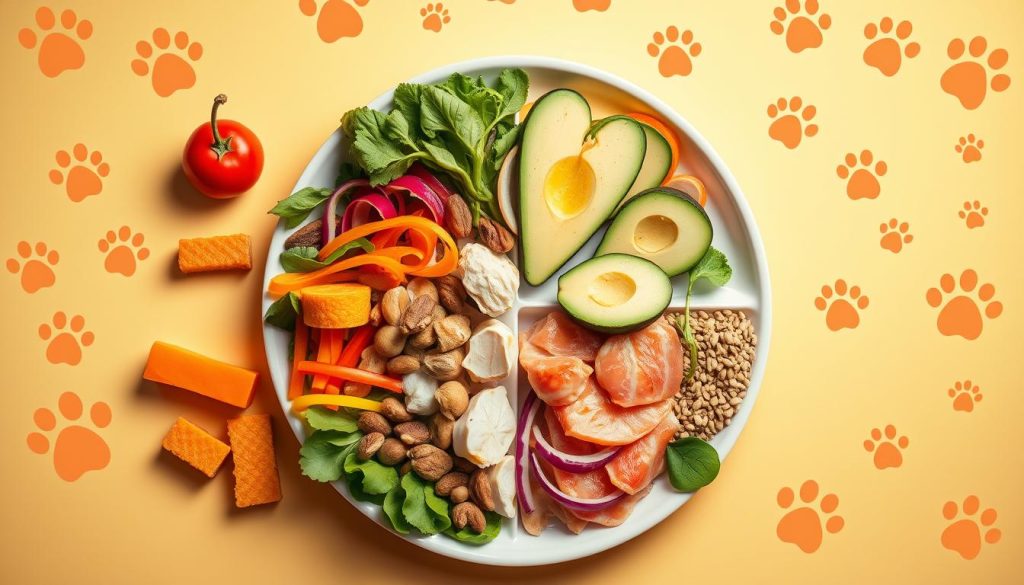As a devoted pet parent, I know how crucial a balanced diet is for your dogs and cats. In this guide, I’ll share effective pet diet plans to keep your furry friends healthy and happy. I’ll cover everything from understanding your pet’s nutritional needs to choosing the right food and portion sizes.
Whether you have a playful puppy, an energetic feline, or a senior pet, a healthy diet is key. I’ll help you understand the factors that influence your pet’s nutritional needs. This includes age, activity level, and any health conditions they might have.
In this guide, I’ll give you practical tips and insights for selecting the right pet food. You’ll learn how to balance proteins, fats, and carbohydrates. By the end, you’ll know how to create effective pet diet plans. This will help keep your furry friends happy, healthy, and well-nourished.
Understanding Your Pet’s Nutritional Needs
Ensuring your pet’s well-being starts with knowing their nutritional needs. Whether it’s a dog or cat, their age, activity level, and health needs are key. By understanding these, you can create a diet plan that supports their health and happiness.
Assessing Your Pet’s Age and Activity Level
Pets have different dietary needs at different life stages. Puppies and kittens need more calories and nutrients for growth. Adult pets need a balanced diet, while seniors may need special diets for their health.
A pet’s activity level also affects their nutritional needs. Active pets need more calories and protein. Less active pets may need a diet with fewer calories and more fiber.
Consulting with Your Veterinarian
While knowing about pet nutrition is good, the best advice comes from your vet. They can guide you based on your pet’s unique needs. This helps choose the right food and feeding plan for your pet.
Your vet can also suggest dietary changes for pets with health issues. By working with your vet, you can tailor a diet plan to your pet’s pet nutritional needs, dog and cat dietary requirements, pet age and activity level, and veterinary advice on pet diets.
Choosing the Right Pet Food
Finding the right pet food can feel like a big task. But don’t worry, I’m here to help. It’s important to know how to read labels and understand what’s in your pet’s food. This ensures they get the best nutrition for their needs.
Reading Pet Food Labels
When picking out pet food, reading labels is key. Look for details on the pet food ingredients. Check if the proteins, fats, and carbs come from named sources. Stay away from vague terms like “meat by-products” or “animal fat”.
Choose high-quality pet food with clear, whole-food ingredients like chicken or fish. Also, check the guaranteed analysis for nutrient information.
Think about your pet’s age, how active they are, and any health issues they might have. Talking to your vet can help find the best pet food for your pet’s needs.
| Ingredient | Explanation |
|---|---|
| Whole Meat Proteins | Look for named meat sources like chicken, beef, or salmon as the first ingredient, indicating a higher-quality protein source. |
| Whole Grains | Whole grains like brown rice or oats provide valuable carbohydrates and fiber for your pet’s digestive health. |
| Healthy Fats | Fats like omega-3 and omega-6 fatty acids support skin, coat, and overall health. |
| Vitamins and Minerals | A complete and balanced pet food will contain essential vitamins and minerals to meet your pet’s nutritional needs. |
Balancing Proteins, Fats, and Carbohydrates

Keeping your pet’s diet balanced is key for their health. The right mix of proteins, fats, and carbs depends on their age, activity, and needs. Knowing what your pet needs helps them stay healthy and happy.
Proteins are vital for your pet’s muscles and repair. They should make up 25-30% of your pet’s calories. The best sources are animal-based proteins like meat, fish, and eggs.
Fats are important for energy and skin health. They should be 10-15% of your pet’s diet. Good fats include fish oils, chicken fat, and plant oils.
Carbs are not as crucial for meat-eaters but offer energy and fiber. They should be 40-50% of your pet’s calories. Choose complex carbs like whole grains, fruits, and veggies.
By balancing these nutrients, you help your pet stay healthy. Talk to your vet to find the best mix for your pet.
| Macronutrient | Recommended Percentage of Total Calories |
|---|---|
| Proteins | 25-30% |
| Fats | 10-15% |
| Carbohydrates | 40-50% |
Pet Diet Plans: A Comprehensive Guide
As pet owners, we all want our furry friends to stay healthy. In this guide, I’ll share diet plans for dogs and cats of all ages and health levels. I’ll also give tips on making these plans fit your pet’s unique needs.
Whether you have a playful puppy or a calm senior cat, I’ve got you covered. My diet plans will help you find the right mix of proteins, fats, and carbs. Working with your vet, you can make these plans even better for your pet’s health.
A good diet is key to a happy, healthy life for pets. By following this guide, you can create diet plans that keep your pet happy and healthy. Let’s work together to make sure our pets get the best nutrition.

